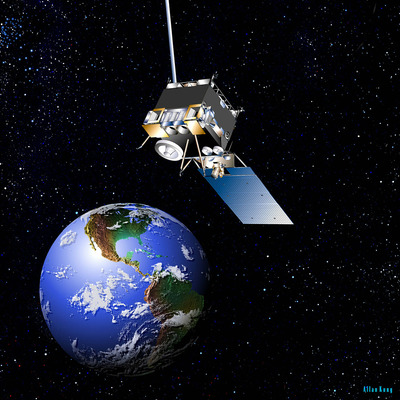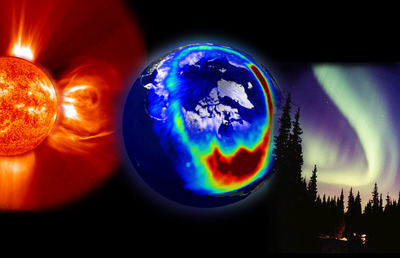Comms problems? Blame the (space) weather
Protecting terrestrial critical communications infrastructure from climatological influences is of vital importance. Researchers are now looking for new ways to protect communications satellites from space weather too.
Massachusetts Institute of Technology (MIT) researchers are investigating the effects of space weather - such as solar flares, geomagnetic storms and other forms of electromagnetic radiation - on geostationary satellites, which provide much of the world’s access to cable television, internet services and global communications.
Geostationary satellites orbit at the same rate as the Earth’s rotation, essentially remaining above the same location throughout their lifetimes. These satellites are designed to last up to 15 years, during which time they may be bombarded by charged particles. Most satellites cover sensitive electronics with layers of protective shielding, but over time, radiation can penetrate and degrade a satellite’s components and performance.
“If we can understand how the environment affects these satellites, and we can design to improve the satellites to be more tolerant, then it would be very beneficial not just in cost, but also in efficiency,” says Whitney Lohmeyer, a graduate student in MIT’s Department of Aeronautics and Astronautics.
Lohmeyer is working with Kerri Cahoy, an assistant professor of aeronautics and astronautics, to understand how sensitive components are to the weather conditions in space, and how space weather may contribute to failures.
In a paper published in the journal Space Weather, the team analysed space weather conditions at the time of 26 failures in eight geostationary satellites over 16 years of operation. The researchers found that most of the failures occurred at times of high-energy electron activity during declining phases of the solar cycle. This particle flux, the scientists theorise, may have accumulated in the satellites over time, creating internal charging that damaged their amplifiers - key components responsible for strengthening and relaying a signal back to Earth.
Lohmeyer says a better understanding of space weather’s effects on satellites is needed not just for current fleets but also for the next generation of communications satellites.
“Users are starting to demand more capabilities,” Lohmeyer notes. “They want to start video-streaming data, they want to communicate faster with higher data rates. So design is changing - along with susceptibilities to space weather and radiation that didn’t used to exist, but are now becoming a problem.”

Space-weather disconnect
Today, engineers design satellites with space weather in mind, using radiation models to predict how much radiation a satellite may be exposed to over its lifetime. Cahoy notes that a satellite’s radiation exposure may vary depending on its orbit. For instance, some orbits are more dangerous than others; engineers choose components that can survive and operate in such environments.
“But space weather is a lot more dynamic than models predict, and there are many different ways that charged particles can wreak havoc on your satellite’s electronics,” Cahoy adds. “The hard part about satellites is that when something goes wrong, you don’t get it back to do analysis and figure out what happened.”
To add another layer of complication, Lohmeyer points out a “disconnect” between satellite engineers and space-weather forecasters.
“The space-weather community provides forecasting mechanisms for companies to help them better operate their satellites, and they may say, ‘Space-weather activity is incredibly high right now, we’re putting out a warning,’” Lohmeyer says. “But engineers and operators don’t really understand what this implies.”
Lohmeyer’s primary goal, she says, is to bridge the gap between the space-weather community and satellite engineers.

Reading the space forecast
To establish a better understanding of space weather’s effects on satellite equipment, Cahoy and Lohmeyer partnered with Inmarsat, a telecommunications company based in London. The researchers analysed more than 665,000 operational hours of telemetry data from eight of the company’s satellites, including temperature and electric-current measurements from the satellites’ solid-state amplifiers. From these data, the researchers analysed scientific space-weather data coinciding with 26 anomalies from 1996 to 2012, the majority of which were considered ‘hard failures’ - unrecoverable failures that may lead to a temporary shutdown of the spacecraft.
The team noted the dates and times of each failure and then analysed the weather conditions leading up to each failure, using observations from multiple space-weather satellites. Such observations included solar-flare activity and geomagnetic storms.
Specifically, the researchers analysed the Kp index, a measurement of geomagnetic activity that is represented along a scale from zero to nine. Satellite engineers incorporate the Kp index into radiation models to anticipate space conditions for a particular spacecraft’s orbit. However, as the team found, most of the amplifier failures occurred during times of low geomagnetic activity, with a Kp index of three or less - a measurement that engineers would normally consider safe. The finding suggests that the Kp index may not be the most reliable metric for radiation exposure.
Instead, Cahoy and Lohmeyer discovered that many amplifiers broke down during times of high-energy electron activity, a phenomenon that occurs during the solar cycle, in which the sun’s activity fluctuates over an 11-year period. The flux of high-energy electrons is highest during the declining phase of the solar cycle - a period during which most amplifier failures occurred.
Lohmeyer says that over time, such high-energy electron activity may penetrate and accumulate inside a satellite, causing internal charging that damages amplifiers and other electronics. While most satellites carry back-up amplifiers, she notes that over an extended mission, these amplifiers may also fail.
“Once you get into a 15-year mission, you may run out of redundant amplifiers,” Lohmeyer says. “If a company has invested over $200 million in a satellite, they need to be able to assure that it works for that period of time. We really need to improve our method of quantifying and understanding the space environment, so we can better improve design.”
Daniel Baker, a professor of astrophysical and planetary sciences at the University of Colorado who was not involved in the research, says that in designing satellites for space, engineers “try to strike a reasonable balance between adequate design against space environmental factors and overdesign that can be immensely expensive and counterproductive”.
The reality, he adds, is that there may always be some operational problems “because space is a harsh place”.
That said, the MIT team’s findings will help engineers design more robust satellite systems and components “to the betterment of us all who depend on space systems”, Baker says.
The research was supported by Inmarsat and by the National Science Foundation.
RFUANZ report: setting the frequency for success in 2025
Last year brought a lot of internal change for RFUANZ, but the association has hit the ground...
ARCIA update: an extended event calendar for 2025
With the addition of Tasmanian events and a conference in Adelaide in September, 2025 will see...
ARCIA update: plans for 2025
ARCIA will be holding a mixture of workshop, conference and networking events in 2025, in the...





